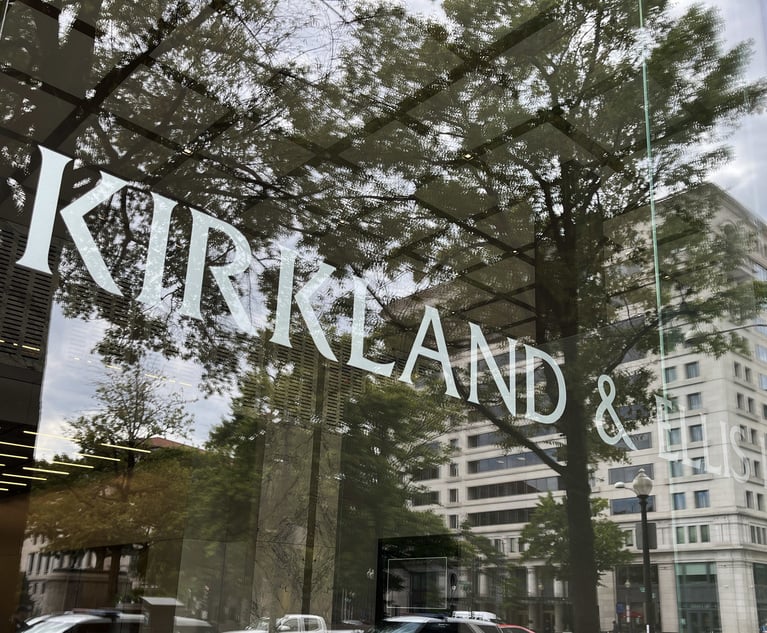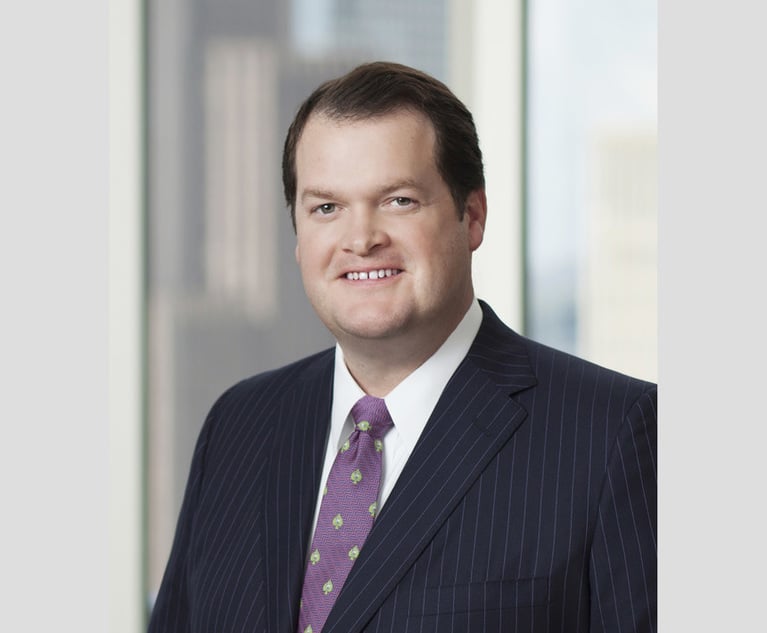Patterson + Sheridan Uses Midsize Status to Stay Nimble
"We can be flexible and try something new with less stress and strain than a larger firm," founding partner Todd Patterson said.
July 29, 2019 at 10:56 AM
9 minute read
 Todd Patterson, Patterson + Sheridan.
Todd Patterson, Patterson + Sheridan.
Firm Name: Patterson + Sheridan
Firm Leader: B. Todd Patterson, founding partner
Head Count: 80
Locations: Houston, Dallas and Waco, Texas; San Jose and San Diego, California; Greensboro, North Carolina; Shrewsbury, New Jersey
Practice Areas: Intellectual Property and Litigation
What is your firm's governance structure and compensation model? We have a three-person management committee in conjunction with a managing partner.
Do you offer alternative fee arrangements?
We have a number of clients with whom we work on a fixed-fee basis for certain activities before the United States Patent and Trademark Office (USPTO). We are also open to an arrangement when litigation expenses are shared with the client in contingency-fee litigation matters.
What do you view as the two biggest opportunities for your firm, and what are the two biggest threats?
We see big opportunities right now for Patterson + Sheridan in expanding our services into growth areas like litigation and transactional law, especially where there are opportunities to utilize the broad array of our technical backgrounds and experience. Unlike most intellectual property law firms, because of strategic recent hires, we can now provide commercial and even criminal litigation services for clients, in addition to intellectual property litigation. The broader array of litigation subject matter that we can address provides much more potential scope for our practice.
As far as threats go, we continue to deal with the problem of the commoditization of patent and trademark preparation and prosecution. Clients continue to demand flat fees and schedules that are unrealistic, in view of the level of legal talent required to “prep and pros” a patent effectively. They are operating, of course, under intense corporate pressure to pursue cost containment and control. Too often there is not enough understanding within the company of the potential risks that come with demanding high-quality legal work at an unrealistically low price.
Our clients in the life sciences arena understand that they have one opportunity to patent an important new product and are willing to cover the cost of having it done properly. But in the electronics and telecommunications industries, for instance, there tends to be an emphasis on volume and managing to metrics above all other considerations, rather than an attentiveness to the quality patent prosecution required to build a strong portfolio that maintains market share for the firm and avoids litigation. We see the same distinctions with our larger trademark clients as they rush to build their newest brands.
Money saved upfront by developing inadequate intellectual property at a low cost may be spent many times over on the back end, defending a weak position from legal challenges. There can also be hidden losses. For example, the company may never receive the income the new product could have generated if the patent had been prosecuted carefully and correctly or the brand had been protected in the right territories.
The legal market is so competitive now. What trends do you see, and has anything, including alternative service providers, altered your approach? Is your chief competition other mid-market firms, or is your firm competing against big firm for the same work?
Patterson + Sheridan competes, as we always have, with a variety of other firms, from very large firms with IP practices, to midsize firms like ours, to sole practitioners working out of their homes who have little overhead and can afford to offer fee sheets to clients with comparatively low fixed fees.
We also encounter firms—most in other parts of the world—that provide technical services such as international “freedom to operate” intellectual property searches to find out where the best opportunities may exist for specific products. We don't object if a client wants to use one of these firms to do an initial search, but we do insist on being involved when it is time to analyze the findings from a legal perspective. A global patent or trademark search is useless unless an experienced IP lawyer closely examines the results.
There is much debate around how law firms can foster the next generation of legal talent. What advantages and disadvantages do midsize firms have in attracting and retaining young lawyers, particularly millennials?
We plan to attract young lawyers by continuing to develop a state-of-the-art training program in intellectual property law that will set our young associates apart from all others. We want our firm to become known for offering this exceptional training process. We know, of course, that once our attorneys are so exceptionally well trained, they will become very attractive acquisitions for other firms. It will be up to us to meet the challenge of keeping them at Patterson + Sheridan.
We are also considering instituting an innovative flex program. Once an attorney has been with our firm for at least three years and has proven his or her ability to take on a project and work effectively without a lot of micro-supervision, we will allow that attorney, if he or she wishes, to work remotely and only come into the office about one week out of every month. This will not be a partner-track position, but may suit young attorneys for whom flexibility and independence are more important than long-term income. We are also considering adding a program which will allow an attorney to leave the firm or reduce billable hours for a period of time, typically for child-rearing, and then return to full-time employment to re-focus on a career.
A midsize firm like ours is perfect for introducing these kinds of programs because we can be flexible and try something new with less stress and strain than a larger firm. With large firms, making any significant change can be like trying to turn the Titanic. There is more resistance to change and any real change takes forever to bring on board.
Does your firm employ any nonlawyer professionals in high-level positions (e.g. COO, business development officer, chief strategy officer, etc.” If so, why is it advantageous to have a nonlawyer in that role? If not, have you considered hiring any?
Our management team includes two nonlawyers. One is focusing on developing human resources training programs; the other is working on the financial side of our operation to develop better tools for us to use to run the business. One is currently fulltime; the other, a retired former client, is [with us three-quarters of the time] right now. Depending on how their work develops, we may want them to remain with us permanently. The advantage is that these individuals are not caught up in the day-to-day practice of law or the billable-hour rat race, and can focus entirely on keeping the firm running efficiently and effectively.
What would you say is the most innovative thing your firm has done recently, whether it be technology advancements, internal operations, how you work with clients, etc.?
In addition to the advanced training program and flex programs I mentioned earlier, and our ongoing constant effort to upgrade our technology, perhaps our most innovative move was to acquire a corporate plane which enables us to meet with our clients face-to-face around the country. We wanted to keep our headquarters in Houston, and we do have other offices in Texas, California, North Carolina and New Jersey, but we are great believers in meeting with clients face-to-face wherever they are to discuss complex projects. We don't think our business can always be conducted effectively through emails, phone calls or even via videoconferencing. We also like to be able to bring in the particular attorneys who are best suited to work on a particular project from wherever they are located.
Our plane makes regularly scheduled weekly trips to California, but we also use it to, say, pick up attorneys in New Jersey and take them to a meeting in San Jose or Dallas, or to take attorneys to meet with a client or potential client who is located in a city where we do not have an office. We believe the cost of using our corporate plane has paid for itself many times over in terms of the relationships we have established and the quality of the work we have completed.
Our firm has always been involved in innovation. We don't rest on our laurels. We are constantly looking for ways to improve what we do.
Does your firm have a succession plan in place? If so, what challenges do you face in trying to execute that plan? If you don't currently have a plan, is it an issue your firm is thinking about?
Years ago, when our firm was still very young, we were all stunned when the employee responsible for docketing our cases suddenly died of a heart attack over a weekend. As we scrambled to restore the docketing schedule, we learned very quickly that anyone can be lost and everyone needs to have backup. Our system is set up to give lots of responsibility to managers of practice groups and, under them, to “lead partners” to whom associates report and, yet one more level down, to “lead associates” who are clearly on the partner track. We have backups for our backups!
At each of these levels, the key individuals are being trained to manage and to lead.
This content has been archived. It is available through our partners, LexisNexis® and Bloomberg Law.
To view this content, please continue to their sites.
Not a Lexis Subscriber?
Subscribe Now
Not a Bloomberg Law Subscriber?
Subscribe Now
NOT FOR REPRINT
© 2025 ALM Global, LLC, All Rights Reserved. Request academic re-use from www.copyright.com. All other uses, submit a request to [email protected]. For more information visit Asset & Logo Licensing.
You Might Like
View All
Energy Lawyers Field Client Questions as Trump Issues Executive Orders on Industry Funding, Oversight
6 minute read
Holland & Knight Hires Former Davis Wright Tremaine Managing Partner in Seattle
3 minute read
Kirkland Is Entering a New Market. Will Its Rates Get a Warm Welcome?
5 minute read
Trending Stories
- 1OCR Issues 'Dear Colleagues' Letter Regarding AI in Medicine
- 2Corporate Litigator Joins BakerHostetler From Fish & Richardson
- 3E-Discovery Provider Casepoint Merges With Government Software Company OPEXUS
- 4How I Made Partner: 'Focus on Being the Best Advocate for Clients,' Says Lauren Reichardt of Cooley
- 5People in the News—Jan. 27, 2025—Barley Snyder
Who Got The Work
J. Brugh Lower of Gibbons has entered an appearance for industrial equipment supplier Devco Corporation in a pending trademark infringement lawsuit. The suit, accusing the defendant of selling knock-off Graco products, was filed Dec. 18 in New Jersey District Court by Rivkin Radler on behalf of Graco Inc. and Graco Minnesota. The case, assigned to U.S. District Judge Zahid N. Quraishi, is 3:24-cv-11294, Graco Inc. et al v. Devco Corporation.
Who Got The Work
Rebecca Maller-Stein and Kent A. Yalowitz of Arnold & Porter Kaye Scholer have entered their appearances for Hanaco Venture Capital and its executives, Lior Prosor and David Frankel, in a pending securities lawsuit. The action, filed on Dec. 24 in New York Southern District Court by Zell, Aron & Co. on behalf of Goldeneye Advisors, accuses the defendants of negligently and fraudulently managing the plaintiff's $1 million investment. The case, assigned to U.S. District Judge Vernon S. Broderick, is 1:24-cv-09918, Goldeneye Advisors, LLC v. Hanaco Venture Capital, Ltd. et al.
Who Got The Work
Attorneys from A&O Shearman has stepped in as defense counsel for Toronto-Dominion Bank and other defendants in a pending securities class action. The suit, filed Dec. 11 in New York Southern District Court by Bleichmar Fonti & Auld, accuses the defendants of concealing the bank's 'pervasive' deficiencies in regards to its compliance with the Bank Secrecy Act and the quality of its anti-money laundering controls. The case, assigned to U.S. District Judge Arun Subramanian, is 1:24-cv-09445, Gonzalez v. The Toronto-Dominion Bank et al.
Who Got The Work
Crown Castle International, a Pennsylvania company providing shared communications infrastructure, has turned to Luke D. Wolf of Gordon Rees Scully Mansukhani to fend off a pending breach-of-contract lawsuit. The court action, filed Nov. 25 in Michigan Eastern District Court by Hooper Hathaway PC on behalf of The Town Residences LLC, accuses Crown Castle of failing to transfer approximately $30,000 in utility payments from T-Mobile in breach of a roof-top lease and assignment agreement. The case, assigned to U.S. District Judge Susan K. Declercq, is 2:24-cv-13131, The Town Residences LLC v. T-Mobile US, Inc. et al.
Who Got The Work
Wilfred P. Coronato and Daniel M. Schwartz of McCarter & English have stepped in as defense counsel to Electrolux Home Products Inc. in a pending product liability lawsuit. The court action, filed Nov. 26 in New York Eastern District Court by Poulos Lopiccolo PC and Nagel Rice LLP on behalf of David Stern, alleges that the defendant's refrigerators’ drawers and shelving repeatedly break and fall apart within months after purchase. The case, assigned to U.S. District Judge Joan M. Azrack, is 2:24-cv-08204, Stern v. Electrolux Home Products, Inc.
Featured Firms
Law Offices of Gary Martin Hays & Associates, P.C.
(470) 294-1674
Law Offices of Mark E. Salomone
(857) 444-6468
Smith & Hassler
(713) 739-1250






